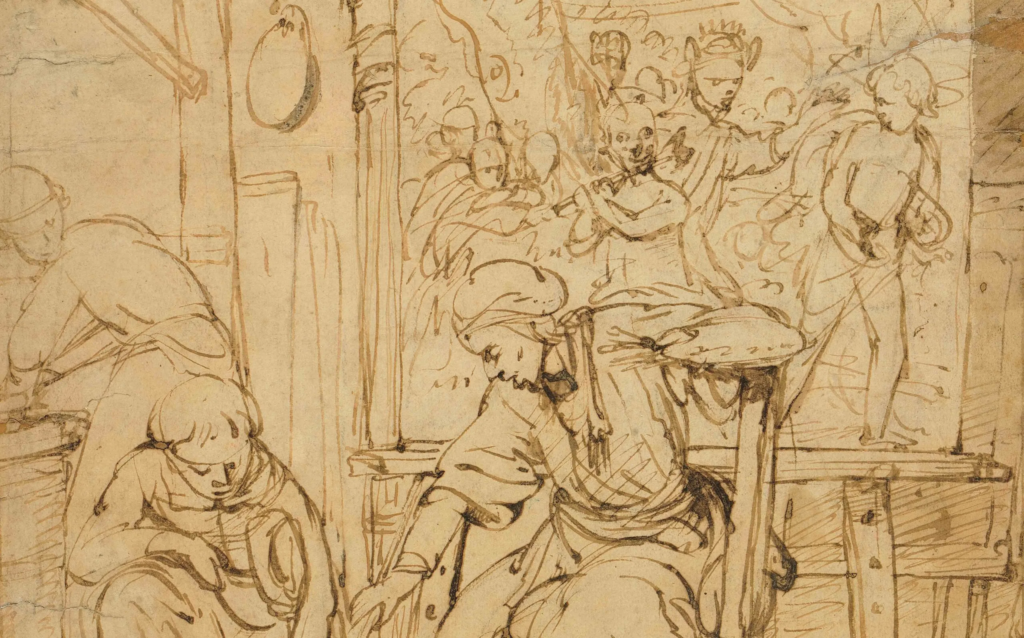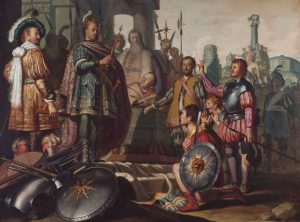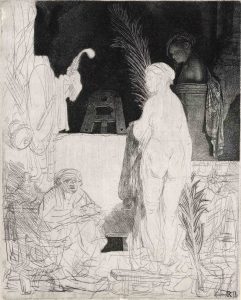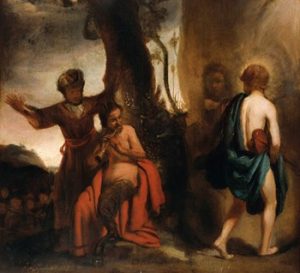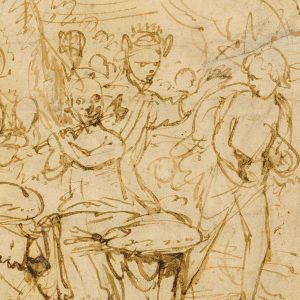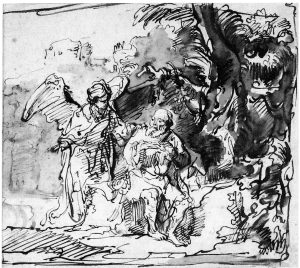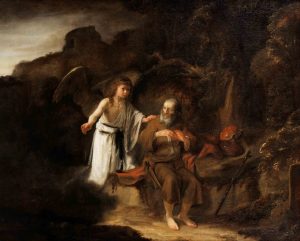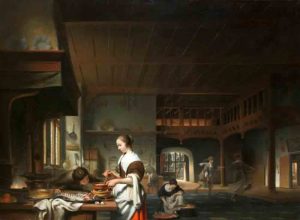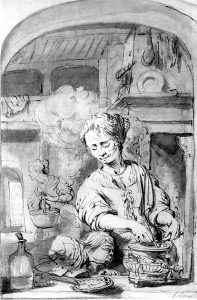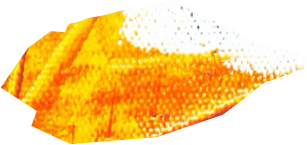In addition to the world before their eyes, seventeenth-century Dutch and Flemish artists also turned their gaze around, to themselves in self-portraits, and even to the ateliers in which they were working, in numerous drawings and paintings. These give us behind-the-scenes glimpses of period practice. This is especially helpful given the precious few written sources they left us, compared to their counterparts in Italy, or France. Such scenes help fill in the gaps, even when we account for artistic license, embellishments, and distortions shaped by prior traditions.1 One example in the Liberna Collection in Mettingen, a drawing in pen and wash, is particularly striking because it shows a moment of instruction (fig. 1). A painter points at a large drawing shown to him by a pupil on the floor, with a stick or brush in his hand. He pauses from his work on the painting taking shape on his easel behind him to offer instruction and correction. It is of course important to know whose viewpoint this was. Until now, the existing attribution has led us in the wrong direction, however.
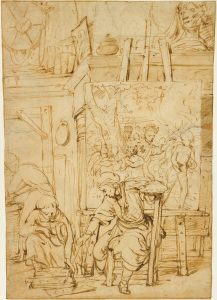
Attribution to Lievens
Scholars have assigned this sheet to an artist closely linked to Rembrandt: his Leiden friend and associate Jan Lievens (1607-1674). This attribution dates from 1983, when this work appeared under his name in the seventh volume of Werner Sumowski’s series Drawings of the Rembrandt School.2 The chief point of comparison with Lievens’s drawings lay in the bold, linear strokes of the pen. This attribution was carried over with the drawing’s presentation in the major monographic Lievens exhibition of 2008-2009, under the aegis of Gregory Rubinstein.3 There appears to be further evidence about the artist and studio here represented sitting high on the ledge. The round shield mounted with a point and the bust fitted out with costume drapery are familiar from depictions of artists at work by Rembrandt and his followers, with whom Lievens associated as well (figs. 2, 3). However, Sumowski dated the sheet quite late, to the 1660s. After departing from Leiden in 1631, Lievens led an itinerant existence, often in financial need. The scenario of this drawing would have to reflect a moment of prosperity enabled by one of several major commissions he won in his later years. Or it may instead show the situation of a fellow artist, or even an imagined situation. This assumes however that it is by Lievens. The detailed interior is unconventional for him however, and we do not recognize the face of an artist who depicted himself almost as readily as Rembrandt.
A Link to Another Artist: Cornelis Bisschop
At the same time we must consider a hitherto unnoticed, alternative link to another member of the Rembrandt circle: the Dordrecht painter Cornelis Bisschop (1630-1674). It is the painting on the easel, depicting The Contest between Apollo and Pan.4 Apollo has summoned Pan to the contest after hearing King Midas boasting about his flute-playing, and the mountain god Tmolos acts as judge. He favours Apollo, who then punishes Midas by endowing him with the ears of a donkey, an animal limited to raucous braying. In the drawn painting, the ass-eared Midas leans in protest toward the contemptuous Apollo to the right, while Pan raises his pipe to the viewer. The composition and figures relate directly to Bisschop’s depiction of the same theme in The Bader Collection at the Agnes Etherington Art Centre in Kingston, Ontario (fig. 4).5 Especially evident is the silhouette of Apollo, carrying a violin under his arm, and walking away to the right while turning for one last glance at Midas (fig. 5). Only, in the painting he turns his back to us. The disgraced Midas echoes the drawn figure’s unusual pose more closely, albeit in mirror image, with his arms flung out in exclamation against the negative judgement of the mountain god Tmolos. His champion, Pan, is likewise shown much as in the drawing, holding his pipe to his lips and turned slightly to the left. The tree also takes a similar place; only the unconventional representation of Tmolos, as a ghostly face (likely a self-portrait) in a cloud, is not reflected in the painting drawn into the sheet in Mettingen. The cloud itself is shown. The Kingston painting had previously been attributed to various Rembrandt pupils, including Barent Fabritius, Gerbrand van den Eeckhout and Nicolaes Maes, until Sumowski assigned it to Bisschop in 1989. It aligns with the smooth and broad rendering of surfaces and figures Bisschop had developed by the later 1650s.
This striking connection raises the possibility that Bisschop, and not Lievens, is the author of the Mettingen atelier scene. His drawings are not well known, however. Werner Sumowski did discuss the artist in his series on the paintings of the Rembrandt school,6 but not in his series on the drawings. At least, not in the published volumes. This series remains incomplete, as many scholars know: we are still waiting for the bibliography to complete the authour-date references in the text. Sumowski passed away in 2015, and shortly thereafter the Rembrandt House Museum learned that he had bequeathed the manuscript of an unpublished Addendum volume. Contact with the series publisher Abaris books then revealed the existence of another unpublished volume, of Anonymous drawings. It contained the long awaited bibliography. Both will be translated, and prepared for pubication in 2023, with the support of Bader Philanthropies. The Addendum volume contains a small section of five drawings attributed to Cornelis Bisschop (who did not feature in the earlier volumes because he was, strictly speaking, not a known pupil of the master himself).7 It leads with a single core drawing (a secure sheet providing the basis for further attributions), one that he had already cited earlier, although only in a note (fig. 6).8 Depicting The Angel Appearing to Elijah, its composition aligns closely with a painting of the same theme, reasonably attributed to Bisschop, last with the Chicago collector and opera tenor Harry Moore (fig. 7).9
The handling in this drawing shows prominent, open and imprecise strokes of the pen, like what we see in the Mettingen atelier scene, in contours and hatching. There is a conspicuous tendency to abrupt, forceful curves, producing a lumpiness in the figures and foreground. The shading in patches of wash and vigourous looping hatching contributes further to an overall gnarly effect, at the expense of overall concentration. Bisschop evidently sought to underscore the emotional drama of Elijah’s rescue with these expressive elements. They resurface in the painting, in milder form. They were evidently an early stylistic direction. One can draw a parallel to the turbulence and clutter of the composition of the Mettingen drawing. It likewise features short, forceful curved contours, but they are generally smoother and more fluid, possibly reflecting development away from youthful bravado and dependence on his teacher.
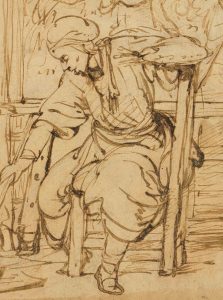 |
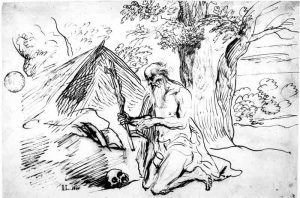 |
These qualities at the same time point away from the traditional attribution to Lievens. Significant differences emerge already in the comparison with the drawing Sumowski cited in support of his attribution, the St. Jerome in Dusseldorf, signed and dated 1665 (fig. 9). There, the figure of Jerome shows Lievens’s typically extended, taut strokes, in contrast with the busy, tight rounded curves in the atelier scene (paralleling the rounded, abstract forms of his later paintings). Jerome’s massive figure achieves monumental presence, typical for Lievens, as is the powerful focus that he generated by accentuating Jerome’s rugged features. In the Mettingen sheet the instructing painter instead cuts a svelte, agile figure, and his face blends into the diffuse pattern of lines mapping his figure. The overall composition there is agitated, and turbulent. The lines yield a more painterly effect, in part due to the fully loaded pen, even leaving pools in various places, as seen also in the Elijah. This technique yields softer surfaces and tones, as opposed to Lievens’s sharp, hard effect of hatching in the Jerome, generated with forceful, elastic strokes.
A Second Late Drawing Linked to Bisschop
In the further exploration of the possible attribution of the Mettingen sheet to Bisschop, we are confronted by the lack in the literature of a secure, later drawing that could serve as a reference core work for the period in which it would be expected to fall, around 1660-1670. However, a candidate does emerge among the drawings Sumowski attributes to Lievens, in another another anomalous sheet, which again offers a previously unnoted, direct link to a late painting by Bisschop.10 The vertical kitchen scene with a maid formerly with Houthakker in Amsterdam (fig. 11) closely relates to Bisschop’s striking kitchen scene in the museum in Dordrecht (fig. 10). Both exhibit a similarly oversized setting, a space with a particularly high ceiling, even incorporating an elevated gallery at the back, above an arched doorway. The motif of the boy blowing on the coals in the brazier is another clear, even decisive, link between painting and drawing; likewise that of the striding figure farther back (who is in turn similar to the bowed-over assistant at the mixing stone in Mettingen). The many correspondences strongly suggest that Bisschop is the author of this drawing.
In turn, it shows strong links to the Mettingen atelier scene, which lend support to the proposed attribution of that drawing to Bisschop. The drawn Kitchen Scene includes a similarly leaning, dynamic main figure contributing to a turbulent composition. The pen handling is dominated by tight curved lines drawn with a loaded pen, leaving pools of ink. Furthermore, both sheets show a structure of washes in a range of tones, an approach Lievens had largely left behind after his early years in Leiden; in his mature drawings he favoured hatching for tone, with strong contrasts, occasionally supplemented by wash.11 In addition, there is even a curious but telltale shared trait, of a slash in the cheek of the main figure in both, an exaggerated suggestion of the cheekbone, with artificial effect. The high fireplace mantel provides yet another distinctive link underscoring Bisschop’s authorship of the Mettingen sheet. As it inclines less to decorative effect, it more likely dates a bit earlier than the kitchen scene, to around 1660.
Context: Van Hoogstraten and Later Rembrandt Pupils in Dordrecht c. 1655-1660
The proposed attribution of the atelier scene to Bisschop places its origins among artists who were well acquainted with Rembrandt (much like Lievens was), but demonstrably more keenly interested in discussions concerning artistic theory and practice. Bisschop associated with various pupils of Rembrandt not just by way of tutelage under Bol in Amsterdam, around 1650-1652, but even more so in his subsequent years of practice back in his native city. Dordrecht became a hotspot of artistic activity oriented towards Rembrandt, after several native pupils returned to settle there after instruction under him, around 1653/54,12 and especially after the return of the older pupil and teacher Samuel van Hoogstraten from travels, in 1656.
It appears more than likely that Bisschop cultivated direct ties with Van Hoogstraten.13 His use of tonal washes in the atelier scene is closely tied to Van Hoogstraten’s distinctive pictorial combination of pen and brush in many of his drawings. It shows up as well in the work of Abraham van Dijck, pupil of Rembrandt and Van Hoogstraten, and evidently also a friend of Bisschop.14 Bisschop may also even have taken the prompt for the theme from Van Hoogstraten, who incorporated a painting of the famous mythological musical contest, with a calmer and more spacious composition, in one of the illusionistic interior spaces in his famous Perspective Box in the National Gallery in London, painted in Dordrecht around the same time as Bisschop’s panel (fig. 13).15
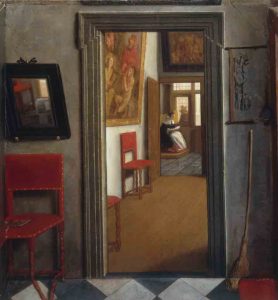
This shared interest was the likely context in turn for Bisschop’s production of illusionistic cutout paintings. They drew such attention that they ended up the focus of Arnold Houbraken’s biography of him. He is the only artist (of over six hundred presented) Houbraken identifies as producing them, and he goes on to relate that he placed them throughout his house in logical contexts, with the aim of pleasurably deceiving the unsuspecting viewer.16 Previously unnoted, the verso of the Kingston panel features a related illusionistic rendering of wood panelling, with edges skilfully articulated in light and shade to evoke the fall of light. The unusually thick (1 cm), unbeveled panel appears to have been incorporated into a three-dimensional architectural or furniture fixture, such as a door. The parallel with Houbraken’s description of cutout paintings is conspicuous, and supports the attribution made by Sumowski (unaware of these features), to Bisschop (fig. 14). Bisschop evidently followed the older master’s interest in illusionistic effects. He was probably aware of Van Hoogstraten’s triumph at the Vienna court with a similar visual deception, which earned him a gold chain from the Emperor.17 Houbraken dismissed the cutouts as trifling (consistent with his prioritization of idealization and lofty subject matter). But they likely expressed a serious interest in evoking the visible world, and how we perceive it, aligned with the core aim of Van Hoogstraten’s treatise, Inleyding tot de Hooghe Schoole der Schilderkonst, published in the year of his death, 1678.18 In a similar vein, Bisschop also followed Van Hoogstraten in the perspectival rendering of interiors. His kitchen scene in Dordrecht is striking for the grandeur it lends to the everyday theme, and he very likely sought to conjure a parallel to Van Hoogstraten’s monumental fantasy architectural scenes.19
Interest in Theory and Art Instruction
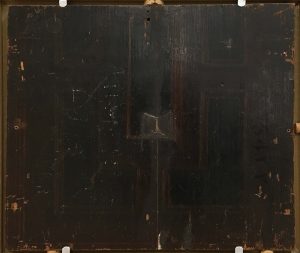
The wider function of Van Hoogstraten’s treatise was art instruction, the very action displayed in the Mettingen drawing. Neither Van Dijck nor Bisschop is known to have had pupils, so it is very tempting to see this drawing as evoking the atmosphere in the studio of Van Hoogstraten, Dordrecht’s most prominent art pedagogue. There does seem to be a resemblance to Van Hoogstraten, for instance in the full lips and straight nose, but a clearly identifiable portrait may not have been intended here, but instead simply the figure of an artist. Even more than for his art, Van Hoogstraten is famous for his treatise, which in the first place aimed to teach the young painter. In nine “books”, each thematically associated with one of the nine Muses, he presented his extensive knowledge of the practice of painting, some of which he inherited from his own teacher Rembrandt. A vast array of rhetorical terms and principles are cited and applied in defining this art and encouraging young pupils in its practice. In one touching anecdote he recalls stern correction of a drawing by his teacher Rembrandt,20 which is eerily conjured in the painter’s assertive and insistent pose here, doing precisely the same thing. Perhaps the painting on the easel, showing the rejection of Pan’s unrefined music, was meant to underscore the significance of sound aesthetic judgement.
Drawings for Connoisseurs: Demonstrating Theory in Practice
The function of such a scene would have been similar to the two well-known drawn views of Rembrandt’s workshop in the 1650s.21 One, in Darmstadt, by pupil Constantijn Daniël à Renesse, anecdotal and possibly imagined but based on direct experience, shows Rembrandt himself leading a session of study from the nude model by pupils and fellow artists.22 The other is Rembrandt’s own pictorial rendering of Rembrandt’s studio in the Ashmolean Museum, which likewise demonstrates drawing from the nude model.23 Often linked to Rembrandt’s 1654 painting of Bathsheba in the Louvre,24 it actually corresponds more closely in costume, setting, and unusual half-nude pose to Rembrandt’s famous etching of A Half-Dressed Model by a Stove.25 This richly tonal print is signed and dated 1658, and was conceived as a masterwork, comparable to the Hundred-Guilder Print. It was subsequently hotly pursued by connoisseurs, in all of its states, as Arnold Houbraken relates with exasperation.26 The lavish, worked-up drawing in Oxford, showing his studio arrangement, was likely produced for the same audience: it quite distinct from Rembrandt’s spontaneous figure studies from life. Connoisseurs valued drawings precisely for their spontaneous reflection of initial artistic ideas and conceptions, compared to finished paintings, and Rembrandt too fed this interest with such works. The liefhebbers would have noted and appreciated the clear rendering in a pictorial technique of the lighting effect, also seen in the etching, drawing attention to Rembrandt’s innovative use of a sheet of cloth suspended high before the window, to capture more daylight and reflect it down, providing light from above, such as also recommended by Willem Goeree.27
Bisschop evidently likewise reflected on an recommended aspect of artistic practice in this remarkable rendering of an artist teaching his young pupil. It issued a backstage pass to knowledgeable and enthusiastic connoisseurs. They would also have appreciated Bisschop’s illusionistic paintings, and would have considered it obligatory to visit the artist in the studio. There they would engage in intelligent conversation on topics related to art, including the instruction of a younger generation of artists.
- For an overview and analysis of the phenomenon of the atelier scene in Dutch art, see Katja Kleinert, Atelierdarstellungen in der niederländischen Genremalerei des 17. Jahrhunderts : realistisches Abbild oder glaubwürdiger Schein?, Petersburg 2006.
- Werner Sumowski, Drawings of the Rembrandt School, vol. 7, New York 1983, pp. 3648-3649, no. 1636bx (ill.).
- Arthur K. Wheelock, ed., Jan Lievens. A Dutch Master Rediscovered, exh. cat. Washington: National Gallery of Art; Milwaukee: Milwaukee Art Museum; Amsterdam: The Rembrandt House Museum 2008/09, p. 246, no. 106.
- And not that between Apollo and Marsyas, as indicated by Sumowski.
- No painting of this theme is known by Lievens. There was a depiction of the contest between Apollo and Marsyas, showing Apollo playing the lyre, in the sale of the collection of the Count of Arundel, likely the same work later with the widow of Jürgen Ovens in 1691. See Hans Schneider and Rudi Ekkart, Jan Lievens: sein Leben und seine Werke. Amsterdam 1973, pp. 110-111, no. 78.
- Werner Sumowski, Gemälde der Rembrandtschüler, Landau 1983-1994, vol. 6 (1994), pp. 3691-3692, nos. 2185a-2194.
- Nos. 2857-2861 in: Sumowski, Drawings (see note 2), vol. 12, Addenda (in translation, forthcoming in 2023).
- Ibid., vol. 3, p. 1965, note 65. Currently assigned no. 2857 in vol. 12 (see note 2); sale, Paris (Christie’s), 21.3.2002, lot 114.
- Ibid., vol. 3, pp. 1961, 1965, 1977 (illus.). Sale, London (Bonhams), 29 October 2014, lot 147 (colour illus.).
- Amsterdam, Sotheby’s, 11 November 1997, lot 25, colour ill., as Lievens. Sumowski is far more hesitant here than with the Mettingen drawing: Drawings (see note 2), pp. 3904-3905, no. 1757xx, illus.: “…an unqualified attribution cannot be entertained because there is no material for comparison.”
- Jan Lievens, Peasant Dwelllings under Trees with Milkmaid, pen in brown and brush in brown and grey, 108 x 193 mm, Dresden, Kupferstichkabinett, Staatliche Museen Dresden, inv. no. C 1453; see Sumowski, Drawings (see note 2), pp. 3724-3725, no. 1672 (illus.).
- See: Michiel Roscam Abbing, De schilder & schrijver Samuel van Hoogstraten, 1627-1678. Eigentijdse bronnen & oeuvre van gesigneerde schilderijen, Leiden 1993, pp. 40-41; Volker Manuth, “Dordrecht: bakermat voor Rembrandts leerlingen”, Bulletin Dordrechts Museum 3 (2006), pp. 3-7; and: David de Witt, Abraham van Dijck (1635-1680). Life and Work of a Late Rembrandt Pupil, Zwolle 2020, pp. 11-13.
- As also observed in Paarlberg, Bisschop (see note 12), p. 24.
- On their friendship see De Witt, Abraham van Dijck (see note 4), p. 108.
- David de Witt, The Bader Collection: Dutch and Flemish Paintings, Kingston 2008, pp. 63-64, no. 31), correcting Sumowski’s dating to the early 1660s, with the observation of hesitancy in handling that points to an earlier period.
- Arnold Houbraken, De groote schouburgh der Nederlantsche konstschilders en schilderessen, vol. 2, The Hague 1719, p. 220. They seem to have largely been lost. The only example linked to him is A Boy Asleep in an Enclosed Chair, c. 1655/60, oil on wood, 97.2 x 66.5 cm, London, with Johnny van Haeften in 2007; see Sumowski, Gemälde (see note 6), vol. 6 (1994), p. 3692, no. 2192, p. 3776 (illus., as Bisschop). It is unsigned, and clearly derived from a similar work signed and dated 1654 by the Haarlem painter Johannes Verspronck: oil on panel, 96 x 75.7 cm, Belgium, private collection. On this basis it has been attributed to that artist as well see: Rudi Ekkart in: Pride and Joy. Children’s Portraits in The Netherlands 1500-1700, exh. cat. Haarlem: Frans Halsmuseum; Antwerp: Koninklijk Museum voor Schone Kunsten Antwerpen, 2000-2001, pp. 227-229, no. 60. However, the thicker application of paint and harsher contrasts in the London version diverge from the one signed by Verspronck, and indeed more closely approximate Bisschop’s painting style of around 1660. If by him, this would suggest that Verspronck supplied an additional impulse for making such cutout paintings, besides Van Hoogstraten and his championing of illusionism.
- Houbraken, Schouburgh (see note 16), vol. 2 (1719), pp. 157-158.
- See the important analysis by Thijs Weststeijn: The Visible World. Samuel van Hoogstraten’s Art Theory and the Legitimation of Painting in the Dutch Golden Age, Amsterdam 2008.
- Sander Paarlberg, “Bisschop op zijn best. Dordrechts Museum krijgt zijn eigen Melkmeisje”, Bulletin van de Vereniging Rembrandt 25, no. 1, (2015), pp. 22-24, colour illus.
- Samuel van Hoogstraten, Inleyding tot de Hooghe Schoole der Schilderkonst, Dordrecht, 1678, p. 12.
- We do not include a painting attributed to Bisschop: The Young Artist in his Studio, c. 1653, oil on canvas, 90.8 × 76.8 cm, Detroit, Detroit Institute of Arts, inv. no. 38.29, as attributed to Cornelis Bisschop; George Keyes, in: Masters of Dutch Painting: The Detroit Institute of Arts, London 2004, pp. 28–29, no. 8 (ill.). The drawing shown in the lower left, a classic two-chalk drawing on blue-grey paper, underscores the stylistic evidence against his authorship, pointing instead to the circle around Govert Flinck (1615-1660) and Jacob Adriaensz. Backer (1608-1651); perhaps Adam Camerarius (?–1666).
- Constantijn Daniël à Renesse, Rembrandt and his Pupils Drawing from a Nude Model, black chalk, brush in brown, 180 x 266 mm, Hessisches Landesmuseum, Darmstadt, inv. no. AE 665; on the attribution see Peter Schatborn, Rembrandt and his circle: drawings in the Frits Lugt collection, Bussum 2010, p. 335.
- Rembrandt, Rembrandt’s Studio with a Half-Nude Model, c. 1654/58, pen and brush in brown, with white body colour, 205 x 190 mm, Oxford, Ashmolean Museum, inv. no. P.I.192 (WA1855.8): Peter Schatborn in Rembrandt : The Complete Etchings and Drawings, Cologne 2019, p. 269, no. T438 (colour illus., as c. 1654).
- Rembrandt, Bathsheba with King David’s Letter, 1654, oil on canvas, 142 x 142 cm, Paris, Musée du Louvre, inv. no. M.I. 975: Ernst van de Wetering, Rembrandt’s paintings revisited : a complete survey, Dordrecht, Boston and Lancaster 2014, pp. 623-624, no. 231; Volker Manuth, Marieke de Winkel and Rudie van Leeuwen, Rembrandt: the Complete Paintings, Cologne 2019, pp. 507-508, no. 23. As Van de Wetering explains, the pose of Bathsheba was originally conceived with an upward glance and turn of the head.
- Rembrandt, A Woman Sitting Half-Dressed beside a Stove, 1658, etching, buring and drypoint, 226 x 194 mm, in seven states: Erik Hinterding and Jaco Rutgers, The New Hollstein Dutch & Flemish Etchings, Engravings and Woodcuts 1450-1700, vol. 25-II: Rembrandt, Ouderkerk aan den IJssel 2013, pp. 292-294, no. 307.
- Houbraken, Schouburgh (see note 16), vol. 1 (1718), p. 271.
- As discussed by the author in: David de Witt and Franziska Gottwald, “Rembrandt & Light” in: Rembrandt’s Light, exh. cat. Dulwich, Dulwich Picture Gallery, 2019-2020, pp. 33-34 (the date of the drawing mistakenly altered in editing; should read c. 1654/58).
